 Last additions Last additions |

Oiran and her attendants then performed a short but spectacular oiran show on the stage from about 2 pm. おいらんショーApr 20, 2007
|
|

Apr 20, 2007
|
|

おいらんショーApr 20, 2007
|
|

The procession nears the main stage where the procession ends.Apr 20, 2007
|
|

The oiran in clear view near the stage.Apr 20, 2007
|
|

Apr 20, 2007
|
|

They pose in front of the stage and bowed before going backstage.Apr 20, 2007
|
|

Apr 20, 2007
|
|

Four ladies in waiting called shinzo, follow the oiran. They are future oiran. 振袖新造Apr 20, 2007
|
|

Apr 20, 2007
|
|

Apr 20, 2007
|
|

The Oiran Dochu procession proceeds slowly along the Ichiyo cherry-lined street.Apr 20, 2007
|
|

Apr 20, 2007
|
|

Oiran Dochu procession, Ichiyo Sakura Festuval, Tokyo. Her obi sash is tied in the front in a knot called manaita-musubi.Apr 20, 2007
|
|

Elaborate oiran wig weighing about 7 kg or 15 pounds.Apr 20, 2007
|
|

Unlike normal kimono, she wears the obi sashi in the front instead of the back. This is so that she can show off her beautiful obi which would otherwise be covered by the uchikake outer garment.Apr 20, 2007
|
|

花魁道中Apr 20, 2007
|
|

Oiran. Her wig and geta clogs weigh the same (about 7 kg or 15 pounds each) to keep her head and feet balanced. Her whole outfit weighs about 60 pounds (27 kg). That's why she needs his shoulder for support as she walks. 花魁Apr 20, 2007
|
|
|

A large crowd line the narrow street.Apr 20, 2007
|
|

Oiran Dochu procession, Ichiyo Sakura Festuval, TokyoApr 20, 2007
|
|

Baton holderApr 20, 2007
|
|

The kamuro attendants precede the oiran.Apr 20, 2007
|
|

Head of the Edo-Yoshiwara Oiran Dochu procession which started at 1:30 pm. 江戸吉原おいらん道中Apr 20, 2007
|
|

The procession is headed by tekomai geisha who sing.Apr 20, 2007
|
|

At the starting point of the procession, the oiran gets ready to wear her high and heavy wooden clogs.Apr 20, 2007
|
|

Close-up of Ichiyo sakura cherry blossoms. "Ichiyo" means "one leaf." You can see that the flower actually has a small green leaf inside. 一葉桜Apr 20, 2007
|
|

Ichiyo sakura cherry blossom trees line the street where the Oiran Dochu procession will proceed. 一葉桜Apr 20, 2007
|
|

The star and main focus of the festival and procession, the oiran or tayu courtesan.Apr 20, 2007
|
|

Festival banner. The Ichiyo Sakura Festival is held in April along the main Komatsu-bashi-dori street lined with Ichiyo cherry blossoms. These photos were taken on April 14, 2007. 小松橋通りApr 20, 2007
|
|

Entrance to the Ichiyo Sakura Matsuri festival site on Komatsu-bashi-dori near Asakusa, behind Sensoji temple. 第5回浅草観音うら 一葉桜まつり 小松橋通りApr 20, 2007
|
|

The festival lasts all day long, from morning until late afternoon. Incudes a flea market. 小松橋通りApr 20, 2007
|
|
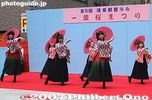
Stage entertainment held on one end of the street. 街角ステージ 第5回浅草観音うら 一葉桜まつりApr 20, 2007
|
|
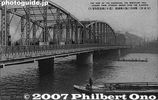
Old postcard showing Ryogoku Bridge over Sumida River and the old Kokugikan in the distance.Apr 10, 2007
|
|

Sumo Photo Museum 相撲写真資料館Apr 10, 2007
|
|

Sumo Photo MuseumApr 10, 2007
|
|

Next to a portrait studio is a small garage with sumo photos on the walls.Apr 10, 2007
|
|

Matsuzaka Inari Shrine. On the right is a small, roofed stone monument engraved with the names of 20 of Kira's samurai who died during the attack. The stone monument was built by a local shopkeeper.Apr 10, 2007
|
|

Inside Sumo Photo MuseumApr 10, 2007
|
|
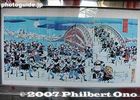
Painting depicting the retainers proceeding to Ryogoku to get Kira's head.Apr 10, 2007
|
|

Site of Lord Kira's Estate or Honjo Matsuzaka-cho Park. Lord Kira was the villain in the famous Chushingura vendetta. 吉良邸跡・本所松坂町公園Apr 10, 2007
|
|

The shaded part of the map shows the area of the original estate and the black square shows the area of this park. It was a huge estate.Apr 10, 2007
|
|
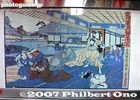
The walls inside have panels such as this one. Painting depicting Lord Asano's attack on Lord Kira at Edo Castle.Apr 10, 2007
|
|

Pet memorial, Eko-inApr 10, 2007
|
|

Inside the park is an Inari Shrine.Apr 10, 2007
|
|

This little park was purchased in 1934 by locals and donated to Tokyo to mark the site of Kira's estate. Free admission.Apr 10, 2007
|
|

Pet memorial, Eko-in temple.Apr 10, 2007
|
|

Marker for the Ako retainers' avenging their Lord who was forced to commit seppuku when he attacked Lord Kira at Edo Castle.Apr 10, 2007
|
|

Apr 10, 2007
|
|

Apr 10, 2007
|
|

CemetaryApr 10, 2007
|
|

The temple itself looks so modern and ordinary that it does not look like a temple.Apr 10, 2007
|
|

Memorials for those who died in maritime disasters.Apr 10, 2007
|
|

Sumo monument in Ekoin temple. Sumo matches were held here regularly from 1833 to 1909 when the Kokugikan sumo stadium was built.Apr 10, 2007
|
|

The temple has many other memorials and monuments.Apr 10, 2007
|
|

Apr 10, 2007
|
|

Gate to Eko-in temple where early sumo tournaments were held. The temple was originally built in 1657 for the repose of over 100,000 people who died in the Great Fire of Meireki (Furisode Fire). 回向院Apr 10, 2007
|
|

Sumo monument in Eko-in temple. Sumo was first held here in 1768. 力塚Apr 10, 2007
|
|

Shop selling sumo goods.Apr 10, 2007
|
|

Tatsunami-beya sumo stable.Apr 10, 2007
|
|

Yokozuna statueApr 10, 2007
|
|

Edo-Tokyo MuseumApr 10, 2007
|
|

Map of Ryogoku. The Kokugikan sumo arena is north of the station, as well as the Edo-Tokyo Museum.Apr 10, 2007
|
|

Ryogoku Station exit. Only one sumo portait hangs here.Apr 10, 2007
|
|

Present entrance to Ryogoku Station (during spring festival).Apr 10, 2007
|
|
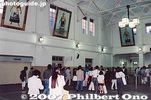
Old entrance to Ryogoku Station with a high ceiling and giant portraits of sumo wrestlers.Apr 10, 2007
|
|

JR Ryogoku Station. This part of the station building is now a beer hall. The train station entrance has moved to the right of this.Apr 10, 2007
|
|

JR Ryogoku Station platform for the Sobu Line.Apr 10, 2007
|
|

JR Ryogoku Station 両国駅Apr 10, 2007
|
|
|

Senzoku-ike station platformApr 09, 2007
|
|

Tokyu Ikegami Line trainApr 09, 2007
|
|

Apr 09, 2007
|
|

This is where the path around the lake ends.Apr 09, 2007
|
|

Hanami at Senzoku-IkeApr 09, 2007
|
|

Senzoku-Ike Station on the Tokyo Ikegami Line. THe train line was built in 1928.Apr 09, 2007
|
|

Shrine on BentenjimaApr 09, 2007
|
|

Apr 09, 2007
|
|

Bridge to Bentenjima.Apr 09, 2007
|
|

Sakurayama with hanami pinickers.Apr 09, 2007
|
|

The pond is also depicted in woodblock prints such as by Hiroshige.Apr 09, 2007
|
|

Apr 09, 2007
|
|

Bentenjima, a small peninsula connected by a bridge.Apr 09, 2007
|
|

Apr 09, 2007
|
|

Apr 09, 2007
|
|

Hachimangu Shrine. Do not climb on the horse.Apr 09, 2007
|
|

"Senzoku" means "wash feet." One legend says that Nichiren washed his feet in the pond.Apr 09, 2007
|
|

The area with the cherry trees is called Sakurayama.Apr 09, 2007
|
|

Hachimangu ShrineApr 09, 2007
|
|

Hachimangu Shrine toriiApr 09, 2007
|
|

Hachimangu Shrine toriiApr 09, 2007
|
|

BridgeApr 09, 2007
|
|

Apr 09, 2007
|
|

Weeping cherry and Senzoku-Ike Pond. Near Senzoku-Ike Station on the Tokyu Ikegami Line from Gotanda.Apr 09, 2007
|
|

Map of pondApr 09, 2007
|
|

Senzoku-Ike Pond and cherry blossoms.Apr 09, 2007
|
|

Senzoku-Ike Pond has a walking path which goes almost completely around. Only 1.2 km.Apr 09, 2007
|
|

Inside a Yamanote Line train.Apr 09, 2007
|
|

Hanamatsuri paradeApr 09, 2007
|
|

Ikegami Station platform on the Tokyu Ikegami LineApr 09, 2007
|
|

Hanamatsuri Parade on April 8, Buddha's birthday.Apr 09, 2007
|
|

Ikegami Station on the Tokyu Ikegami Line which starts in Gotanda.Apr 09, 2007
|
|

Poster for the temple's spring festival which includes Hanamatsuri.Apr 09, 2007
|
|

Marker for the temple.Apr 09, 2007
|
|

White elephant is usually present during Hanamatsuri. On the day before the Buddha's mother Queen Maya gave birth, she dreamed that a white elephant entered her womb.Apr 09, 2007
|
|

Car for HanamatsuriApr 09, 2007
|
|

White elephant for HanamatsuriApr 09, 2007
|
|

Hanamatsuri Parade on April 8, Buddha's birthday.Apr 09, 2007
|
|

Hanamatsuri Parade on April 8, Buddha's birthday.Apr 09, 2007
|
|

宝塔Apr 09, 2007
|
|

Built in 1828 and made of wood. It is the only tower of its kind in Japan placed outdoors. 宝塔Apr 09, 2007
|
|

Hanamatsuri Parade on April 8, Buddha's birthday.Apr 09, 2007
|
|

Hoto tower 宝塔Apr 09, 2007
|
|

Spring festival site with food and entertainment.Apr 09, 2007
|
|

Graves near Hoto towerApr 09, 2007
|
|

Hoto tower 宝塔Apr 09, 2007
|
|

Gate to HondenApr 09, 2007
|
|

Hoto tower built on the site where Nichiren was cremated. 宝塔Apr 09, 2007
|
|

Hoto means "Treasure Tower." A beautiful building. Ikegami Honmonji, Tokyo 宝塔Apr 09, 2007
|
|

Altar in Kyozo 経蔵Apr 09, 2007
|
|

Honden and temple office on right. 本殿、客殿寺務所Apr 09, 2007
|
|

Nitchodo Hall 日朝堂Apr 09, 2007
|
|

Bell tower 鐘楼堂Apr 09, 2007
|
|

Honden Hall 本殿Apr 09, 2007
|
|

Treasure House 霊宝殿Apr 09, 2007
|
|

Kyozo houses Buddhist scriptures. 経蔵Apr 09, 2007
|
|

Behind the pagoda are many graves.Apr 09, 2007
|
|

Apr 09, 2007
|
|

Apr 09, 2007
|
|

Tea ceremonyApr 09, 2007
|
|

Statue of Rikidozan who was famous for his "karate chop" during the 1950s and early '60s. This famous postwar "Japanese hero" was actually Korean.Apr 09, 2007
|
|

Rikidozan's gravestoneApr 09, 2007
|
|

Apr 09, 2007
|
|

Rikidozan's grave, the temple's most famous grave.Apr 09, 2007
|
|

Statue of Rikidozan (1924-1963) at his grave at Ikegami Honmonji temple, Tokyo. He was a sumo wrestler until 1950 before becoming a pro wrestler.Apr 09, 2007
|
|

Rikidozan's graveApr 09, 2007
|
|

Sign pointing the way to wrestler Rikidozan's grave.Apr 09, 2007
|
|

Five-story Pagoda was another structure which escaped war damage. 五重塔Apr 09, 2007
|
|

Five-story Pagoda and cherry blossoms. 五重塔Apr 09, 2007
|
|

五重塔Apr 09, 2007
|
|

Five-story Pagoda built in 1607, Tokyo's oldest pagoda. 五重塔Apr 09, 2007
|
|

Roof of Soshido Main Hall 大堂Apr 09, 2007
|
|

Back of Soshido Main HallApr 09, 2007
|
|

Doors of Soshido Main Hall 大堂Apr 09, 2007
|
|

Side view of Soshido Hall. 大堂Apr 09, 2007
|
|

People line up to pour sweet tea over the baby buddha. 大堂Apr 09, 2007
|
|

Hanamatsuri, Buddha's birthday. When the Buddha was born, he walked seven steps and said, "I am my own Lord through Heaven and Earth," and pointed one hand to Heaven and the other to Earth. Apr 09, 2007
|
|

Hanamatsuri, Buddha's birthday on April 8. A small statue of the baby Buddha is in a miniature temple called Hanami-do (花御堂). This is Ikegami Honmonji temple in Tokyo.Apr 09, 2007
|
|

See the baby buddha's hands pointing to Heaven. Sweet tea is poured over a statue of a baby buddha. According to legend, sweet rain (or perfumed water) fell when the Buddha was born.Apr 09, 2007
|
|

大堂(祖師堂)Apr 09, 2007
|
|

Inside Soshido Hall, view of right side. 大堂(祖師堂)Apr 09, 2007
|
|

Soshido Hall altar 大堂(祖師堂)Apr 09, 2007
|
|

Inside Soshido Hall, view of left side. 大堂(祖師堂)Apr 09, 2007
|
|

Niomon Gate 仁王門(三門)Apr 09, 2007
|
|

The hall was reconstructed in 1964 financed by donations from all over Japan. It is a ferro-concrete structure. 大堂(祖師堂)Apr 09, 2007
|
|

Soshido Main Hall, Ikegami Honmonji. The original Main Hall was burned during an bombing raid in April 1945. 大堂(祖師堂)Apr 09, 2007
|
|

Incense burnerApr 09, 2007
|
|

Way to Ikegami Honmonji Temple. Belonging to the Nichiren Sect, this is one of Tokyo's major temples.Apr 09, 2007
|
|

Map of temple grounds. There are both traditional and modern buildings.Apr 09, 2007
|
|

Route 1 in Nishi-Gotanda toward TOC.Apr 09, 2007
|
|

JR Gotanda Station, west side being completely redeveloped in April 2007.Apr 09, 2007
|
|

JR Gotanda Station and Tokyu, road to Sony HQApr 09, 2007
|
|

Route 1 in Higashi-GotandaApr 09, 2007
|
|

JR Gotanda Station, east sideApr 09, 2007
|
|

JR Gotanda Station, west side being completely redeveloped.Apr 09, 2007
|
|

JR Gotanda Station, east sideApr 09, 2007
|
|

JR Gotanda Station, east sideApr 09, 2007
|
|

JR Gotanda Station, east sideApr 09, 2007
|
|

JR Gotanda Station, east sideApr 09, 2007
|
|

JR Gotanda Station, east entrance 五反田駅Apr 09, 2007
|
|

Apr 09, 2007
|
|

JR Gotanda Station as seen from Keihin Kyuko Gotanda Station.Apr 09, 2007
|
|

JR Gotanda Station, east entrance 五反田駅Apr 09, 2007
|
|

Monument says that the practice of visiting all the seven shrines for the Seven Gods of Good Fortune started here.Apr 09, 2007
|
|

Sight from the shrine's hill. Keihin Kyuko train runs parallel to the old Tokaido Road in Shinagawa.Apr 09, 2007
|
|

Daiichi Keihin highway in front of the shrine and Shin-Bamba Station on the Keihin Kyuko Line.Apr 09, 2007
|
|

Memorial for knives.Apr 09, 2007
|
|

KappaApr 09, 2007
|
|

Kaguraden for sacred dances.Apr 09, 2007
|
|

Cherry blossomsApr 09, 2007
|
|
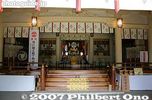
Honden main hall, Shinagawa ShrineApr 09, 2007
|
|

Apr 09, 2007
|
|

Honden main hall, Shinagawa ShrineApr 09, 2007
|
|

Apr 09, 2007
|
|

Third toriiApr 09, 2007
|
|

Honden main hall, Shinagawa ShrineApr 09, 2007
|
|

Apr 09, 2007
|
|

Honden main hall of Shinagawa Shrine, one of Shinagawa Ward's major shrines. Dedicated to Amenohirinome-no-Mikoto, Susano-o-no-Mikoto, and Uganome-no-Mikoto. Near Shin-Bamba Station North Exit on the Keihin Kyuko Line from Shinagawa Station. Apr 09, 2007
|
|

ToriiApr 09, 2007
|
|

Second toriiApr 09, 2007
|
|

Marker for "New 100 Views of Tokyo."Apr 09, 2007
|
|

Sightseeing markerApr 09, 2007
|
|

Shinagawa Shrine faces Daiichi Keihin, a major highway.Apr 09, 2007
|
|

Shinagawa Shrine 品川神社Apr 09, 2007
|
|

Daikokuten, God of Wealth, Farmers, Agriculture, and Rice. He stands on bales of rice.Apr 09, 2007
|
|

Shinagawa Shrine torii at street level.Apr 09, 2007
|
|

Daiichi Keihin highway. One road which replaced the Tokaido Road.Apr 09, 2007
|
|

Police box looks traditional.Apr 09, 2007
|
|

More pine trees. This one came from Oiso in Kanagawa Pref.Apr 09, 2007
|
|

Rest stop (a bench).Apr 09, 2007
|
|

Aomono-Yokocho Station on the Keihin Kyuko Line. This must be one of the ugliest train stations in Tokyo. The old Tokaido Road goes further beyond, but I stopped here.Apr 09, 2007
|
|

Other shukuba (post towns), especially in the rural areas, have been successful in making their buildings look traditional. But Shinagawa was a total failure in this regard.Apr 09, 2007
|
|

If they could even build one traditional-looking building here, more tourists would come. But the most traditional-looking building is this public toilet.Apr 09, 2007
|
|

These frequent signs saying "Tokaido Shinagawa-juku" try to remind you that you're in Shinagawa-juku.Apr 09, 2007
|
|

Apr 09, 2007
|
|

Apr 09, 2007
|
|

Unfortunately, there are no post town buildings except for numerous shrines and temples.Apr 09, 2007
|
|

The only other traditional things you see are pine trees. This one came from Hamamatsu in Shizuoka.Apr 09, 2007
|
|

Looks like a former police box (koban) next to Shinagawa Bridge.Apr 09, 2007
|
|

Ebara Shrine and priestApr 09, 2007
|
|

Ebara Shrine also holds the Sanno Festival in early June.Apr 09, 2007
|
|

Ebara Shrine is only one of many shrines and temples in this area.Apr 09, 2007
|
|

The shrine is associated with Ebisu, the god of fishermen (notice the fishing pole) and good fortune.Apr 09, 2007
|
|

Apr 09, 2007
|
|

Ebara Shrine. Near Shinagawa bridge and adjacent to cherry-lined Meguro River on the left. 荏原神社Apr 09, 2007
|
|

Ebara Shrine toriiApr 09, 2007
|
|

Bridge to Ebara Shrine.Apr 09, 2007
|
|

Cherry blossoms along the Meguro-gawa River.Apr 09, 2007
|
|

Ebara Shrine torii and bridge.Apr 09, 2007
|
|

Bridge to Ebara Shrine with cherry blossoms.Apr 09, 2007
|
|

Meguro River as seen from Shinagawa Bridge. The river served as the boundary between Kita-Shinagawa (northern Shinagawa) and Minami-Shinagawa (southern Shinagawa).Apr 09, 2007
|
|

Shinagawa Bridge over the Meguro River. After Nihonbashi Bridge in Edo, this was the next major bridge to cross on the Tokaido. 品川橋Apr 09, 2007
|
|

Map of the walking route along Shinagawa-juku.Apr 09, 2007
|
|

Shinagawa Bridge, with a small park on the bridge. 品川橋Apr 09, 2007
|
|

Shinagawa Bridge and Meguro River.Apr 09, 2007
|
|

Site of Shinagawa-juku's Honjin. Seems to be used for parking bicycles... 品川宿 本陣Apr 09, 2007
|
|

Traffic sign for Tokaido Road.Apr 09, 2007
|
|

Sign explaining about the pine tree. Tsuchiyama in Shiga Prefecture was the 49th post town on the Tokaido Road.Apr 09, 2007
|
|

Road to Shinagawa Shrine.Apr 09, 2007
|
|

Shinagawa-juku Honjin marker.Apr 09, 2007
|
|

Pine tree at Shinagawa-juku's Honjin. The pine tree came from Tsuchiyama-juku in Koka, Shiga Prefecture.Apr 09, 2007
|
|

Site of Shinagawa-juku's Honjin. 品川宿 本陣Apr 09, 2007
|
|

More shutter art.Apr 09, 2007
|
|

Site of Shinagawa-juku's Honjin. 品川宿 本陣Apr 09, 2007
|
|

Isshinji Temple is a branch of Narita-san.Apr 09, 2007
|
|

Painting shutter art. Looks like a pine tree.Apr 09, 2007
|
|

Isshinji Temple, associated with the god of longevity, Jurojin.Apr 09, 2007
|
|

Isshinji Temple gate signApr 09, 2007
|
|

Still just modern buildings in Shinagawa-juku, looking like any ordinary street in Japan.Apr 09, 2007
|
|

"Kita-Shinagawa Koko Kara"Apr 09, 2007
|
|

Shinagawa-juku road markerApr 09, 2007
|
|

Shinagawa-juku famous spot marker. It reads "Kyu-Tokaido no Nigiwai" meaning "Full of People on the Tokaido."Apr 09, 2007
|
|

Sign explaining about Shinagawa-juku. There were 1,600 buildings and a population of 7,000. The town was right on the waterfront which used to exist before the land reclamation.Apr 09, 2007
|
|

Apr 09, 2007
|
|

Rest stopApr 09, 2007
|
|

Message in EnglishApr 09, 2007
|
|

Hinkai ParkApr 09, 2007
|
|

Shinagawa beerApr 09, 2007
|
|

Apr 09, 2007
|
|

Apr 09, 2007
|
|

It is unfortunate that no one thought about preserving this historic stage town on the Tokaido Road. Tokyo may be too urban to have a long road of traditional buildings.Apr 09, 2007
|
|

Apr 09, 2007
|
|
| 71466 files on 284 page(s) |
 |
 |
236 |  |
 |
|